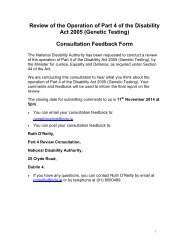advances
s8qx303jAhT
s8qx303jAhT
Create successful ePaper yourself
Turn your PDF publications into a flip-book with our unique Google optimized e-Paper software.
<strong>advances</strong><br />
BIOTECHNOLOGY<br />
Recycling radioisotopes<br />
World’s first company to recycle the radiolabel carbon-14<br />
Q<br />
uotient Bioresearch is a contract<br />
research organisation that provides<br />
radioactive tracers. Working with<br />
clients across the globe in the<br />
pharmaceutical, biotechnology,<br />
agrochemical, chemical and animal<br />
health industries, the company<br />
delivers early stage and specialist<br />
drug development services,<br />
testing how drug candidates and<br />
medicines are metabolised and<br />
react with the body.<br />
Radiolabelling tends to produce a large<br />
amount of synthetic waste. Quotient<br />
Bioresearch recently benefitted from<br />
funding to develop a recycling plant for its<br />
raw material, meaning the bi-products of<br />
carbon-14 synthesis can be recycled and<br />
harnessed.<br />
The company has now become the world’s<br />
first to recycle carbon-14, which has been<br />
A radioactive tracer, or radiolabel, is<br />
a chemical compound in which one or<br />
more atoms have been replaced by a<br />
radioisotope. Carbon-14 is a radioactive<br />
isotope of carbon. It is present in<br />
organic materials and can be used as<br />
a radioactive tracer for metabolism<br />
studies.<br />
suffering a supply shortage in recent years.<br />
As a solution to both the supply and waste<br />
issues, the recycling plant allows this raw<br />
material to be re-used, alleviating demand<br />
and offering a more sustainable way of<br />
working.<br />
The technology converts synthetic waste<br />
using a process of isotopic enrichment. The<br />
process involves oxidising the waste to form<br />
carbon dioxide in an electrochemical cell<br />
with a nitric acid electrolyte, which is then<br />
converted to methane.<br />
The isotopic forms of methane are easier<br />
to separate by thermal diffusion, because<br />
the mass difference in between isotopes is<br />
relatively large. The gas mixture is passed<br />
through a column with cold walls and a<br />
heated central rod. The lighter methane<br />
molecules move towards the heated rod<br />
and the heavier methane moves to the cold<br />
wall. This enriched methane product is<br />
re-oxidised to form highly enriched carbon<br />
dioxide. The reaction in the plant takes less<br />
than 2 hours and creates a substance with<br />
a purity of 99.6%.<br />
To demonstrate the enriched carbon<br />
dioxide’s efficacy for radiolabelling,<br />
researchers used it to label an antiinflammatory<br />
generic drug with the<br />
gaseous carbon-14 precursor.<br />
The company is also exploring how to<br />
re-use clients’ unused excess material,<br />
so that excess units of carbon-14 can<br />
be retrieved and recycled. In time,<br />
the company plans to explore every<br />
opportunity to source materials to put<br />
through the plant, reducing global<br />
emissions to the environment, reducing<br />
waste disposal issues and costs, and<br />
creating a more sustainable future for<br />
industry.<br />
Profile<br />
Profile<br />
Product<br />
Recycling system for carbon-14<br />
Applications<br />
Sustainable radiolabelling<br />
for drug discovery<br />
Contact<br />
Mark Waring<br />
The Old Glassworks<br />
Nettlefold Road<br />
Cardiff CF24 5JQ. UK<br />
T: +44 (0) 2920 474 907<br />
E: Mark.Waring@quotientbioresearch.com<br />
W: www.quotientbioresearch.com<br />
Issue 79/Summer 2016<br />
15




